Will Jemison
Since the first week of November, we have seen a drastic shift in the balance of power of our nation. The party that enjoyed some level of comfort as the leading Senate party, has now found itself having to reinvent how they manage their affairs and interactions in dealing with the party that is, in theory, in control of Congress.
The new majority party in Congress is also now forced to reflect on how they got to this point and how they will, in turn, be forced to deal with a new degree of scrutiny that comes with the great gift in which they have been given, leadership.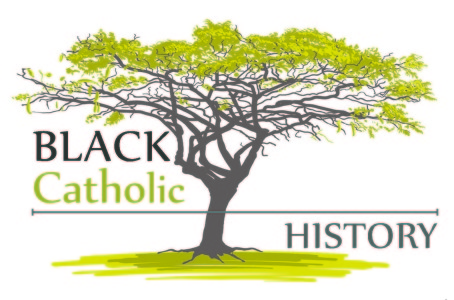
As we begin our observance of Black Catholic History Month, let’s consider the above reference and compare ourselves as our elected officials must do, with a strong lens focused on inflection. In the state of Mississippi, Catholics represent a relatively small percentage of those who identify as Christian.
However, our presence is often felt at the highest levels of both local and state government as a force for positive change in social justice and civil issues that affect all Mississippians, regardless of religious affiliation. Of course, this involves each group within our church having to be at the table and answer the call to service when tasked.
Predominately black parishes have historically been the beacon of hope within traditionally underserved communities in Mississippi. During the days of Jim Crow, our parish schools were often the only schools where children could receive a quality education without fear of the school closing for over-excelling or for lack of books, desks, teachers and other necessities afforded majority schools.
Religious sisters from across the nation, including the Sisters of the Holy Family, Oblate Sisters of Providence, School Sisters of Notre Dame, Dominican Sisters, and Sister Thea Bowman’s order, the Franciscan Sisters of Perpetual Adoration, all came to Mississippi with a sense of purpose to, in their own way, change the educational landscape of a state that for decades refused to invest in the sustainable growth of black Mississippians.
Although many of these challenges still exist today, the landscape of our state changed when religious sisters and brothers, priests, lay associations and ordinary citizens united to carefully discern their charism and set forth to change the lives of many they didn’t know.
As we celebrate the many individuals who have contributed to the tapestry of our diocese and the larger church, let’s also take time to reflect on how we achieved the many opportunities given to us and more importantly, what we will do with the blessings we now have.
Will we allow our opportunities to help others and bring more people to the church go unused? Will we allow our blessings and the richness of our Catholic faith to die for lack of willingness to reach outside the church and share our gifts?
In honor of Black Catholic History Month, each edition of Mississippi Catholic will feature articles highlighting the many contributions Catholics of African descent have made to the overall church. Special recognition will be given to the four causes for sainthood of American black Catholics who gave selflessly for the growth of Catholicism in the black community. Those causes; Father Augustus Tolton; Venerable Mother Henriette DeLille (Founder of the Sisters of the Holy Family); Mother Mary Elizabeth Lange (Founder of the Oblate Sisters of Providence); and Venerable Pierre Toussaint; each have the possibility of becoming the first black saint from the United States.
Please mark your calendar for the Bishop’s 2015 Martin Luther King, Jr. Celebration on Sunday, Jan. 11 at 3 p.m. in St. Peter Cathedral in Jackson. The keynote speaker is noted civil rights attorney, Benjamin Crump, of Tallahassee, Fl. Crump is best known for his representation of the families of Trayvon Martin, and most recently, Michael Brown of Ferguson, Mo. Also, during this upcoming celebration, we will honor several religious orders who have served our diocese faithfully through the years and welcome the Redemptorist community who are now serving the Mississippi Delta. This event is free and open to the public. A reception recognizing our honorees will immediately follow.
(Will Jemison is the director of the Office of Black Catholic Ministry for the Diocese of Jackson.)
Category Archives: Diocesan News
Presentation offers update on Tolton cause
JACKSON – Brother Gerard Jordan, O.Praem, presented the story of Father Augustus Tolton at Christ the King Parish Saturday, Nov. 8. Brother Jordan is traveling the country on behalf of Bishop Joseph Perry, of the Archdiocese of Chicago. Bishop Perry’s diocese is sponsoring Father Tolton’s sainthood cause.
The Office of Black Catholic Ministry brought the presentation to Jackson. In late September, the archdiocese sealed up all its research about Father Tolton’s life, evidence of two alleged miracles and countless favors into a formal packet to go to the Vatican for the next step, confirmation of the research and verification of the miracles. Part of this step in the journey is for advocates to travel the world, telling the story of Tolton, the first African American diocesan priest in the United States. “Rome has to hear from you,” said Brother Gerard. “You are the church. If you don’t want this to happen, it won’t,” he added.
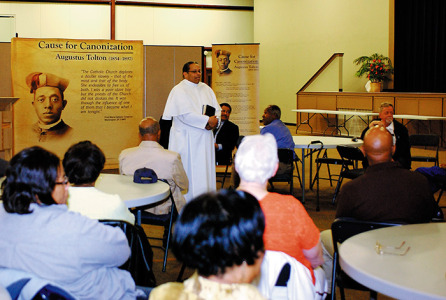
JACKSON – Brother Gerard Jordan, O.Praem, brought a presentation about Father Augustus Tolton to Christ the King Parish Saturday. Nov. 8. The priest is a candidate for sainthood. (Photo by Maureen Smith)
Father Tolton’s story has all the drama and intrigue of a classic American adventure tale. Born into slavery at the cusp of the Civil War, Father Tolton’s brave mother ran away from her owners with her three tiny children in tow. When they were stopped at the Mississippi River by a group of Confederate soldiers, it looked like the group was doomed. A troop of Union soldiers stepped in. The two groups agreed they would put mother and children into a boat in the Mississippi River and it would be up to Martha Tolton to try and get to freedom on the other side.
“The boat was old, they only gave her one oar, the Mississippi River is huge and Martha Tolton had never rowed a boat in her life,” explained Brother Jordan. “When she was half way across the soldiers started shooting at them. (Tolton) said she never missed a beat. Can you imagine? Three babies and a mother who had never been in a boat,” Brother Jordan added. The family made it to shore and eventually settled in Quincy, Illinois.
The pastor in Quincy tried to put 14-year-old Tolton in the parish school, but the white families rose up against him. He was educated by nuns who agreed to tutor him separately. He had a similar experience when he tried to enter seminary. He and his pastor wrote letters to every seminary in the country, but none was ready to accept an African American.
In 1872 letters to the Vatican and help from numerous priests and faithful resulted in his admission to the Collegium Urbanum de Propaganda Fide in Rome. He studied in Rome for six years, spending extra time studying African culture and languages since he assumed he would be sent to Africa as a missionary. He was ordained at Easter in 1886. The cardinal in charge of assignments sent Father Tolton back to Quincy, where hundreds came to his first Mass.
Father Tolton was assigned to St. Joseph Parish in Quincy. Although the parish was meant to serve the African American community, crowds of both white and black faithful came to hear Father Tolton. The pastor at the white parish, St. Boniface, complained to the bishop several times. Father Tolton, frustrated and upset, finally asked to be moved. He opened St. Monica Parish in a storefront in Chicago in 1891 and began raising money for a real structure.
Father Tolton would never see the church completed. He died during a heat wave in July 1897 at the age of 43. In his 11 years as a priest he had attended five gatherings of the Black Catholic Caucus. “Thousands lined the streets of Chicago when he died. Thousands more lined the train route when his body was sent back to Quincy,” said Brother Jordan.
How is it that Father Tolton was so famous at the time of his death, but now very few know his story? Brother Jordan said racism and a lack of promotion caused him to fade into the background, but that now is a critical time for Father Tolton.
“The work begins with you. You have got to tell the story,” he urged. Brother Jordan outlined four priorities for the faithful who wish to support Father Tolton’s cause. “The first and foremost is to pray, asking God to prove to the world that heaven and earth made a connection through the intercession of Father Tolton,” said Brother Jordan. “The second thing that needs to happen is catechesis,” he said. Brother Jordan also brought prayer cards and books for everyone, paid for by Father Ricardo Phipps, pastor of Christ the King. The third step is to tell the story, especially to children. Finally, said Brother Jordan, is to pay the cost for all the research and verification, currently at $264,000.
Brother Jordan closed by saying he has written a plan any parish or group can use to establish small groups who will pray together and share Father Tolton’s story. Father Phipps said he would like to establish a group at his parishes and will start spreading the word in the coming weeks.
Those who wish to learn more about Father Tolton can visit the website www.toltoncannonization.org.
Golfers turn out for Catholic Foundation
GLUCKSTADT – The 2014 Bishop’s Cup golf tournament attracted more than 80 golfers to sunny Lake Caroline Golf Course in Madison County. The tournament helps fund the Catholic Foundation of the diocese.
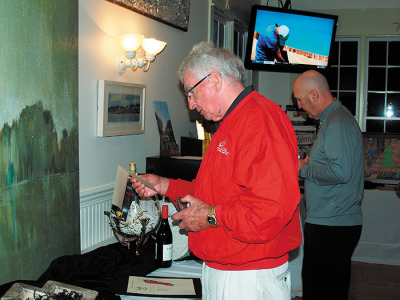
Father Patrick Noonan looks over items in the silent auction at the dinner following the Bishop’s Cup golf tournament.
Teams from parishes vie for the Bishop’s Cup trophy each year. St. Paul Parish in Flowood captured the trophy this year in the new “scramble” format instead of individual stroke play, which had been used in previous tournaments.
St. Paul had four parish teams competing in the tournament. Twelve other parishes had at least one team vying for the trophy and bragging rights for the year. With a scramble score of 55, St. Paul parishioners Dave Clements, Michael Kimbrell, Sean Oakley and Will White made up the winning foursome. Bishop Joseph Kopacz presented them with the trophy at the tournament banquet. St. Dominic Health Services’ team had the second lowest score with a 57.
Other golfers came from Greenwood, the defending champions; Brookhaven, Clinton, Jackson, Leland, Madison Natchez and Vicksburg. For the third year, St. Aloysius High School in Vicksburg has sent members of their golf team to play.
Bishop Kopacz tested his golfing skills along with several other members of the clergy. One foursome even included Father John Kuntz, a priest visiting from Minnesota. Father Charles Loyacono represented the Delta clergy, and Nick Adam represented the diocesan seminarians.
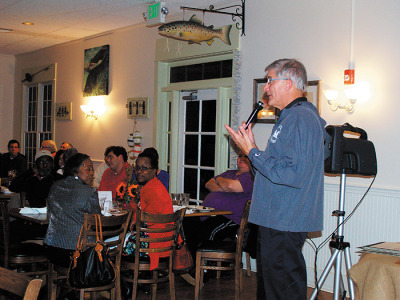
Bishop Joseph Kopacz shares some closing remarks with the banquet attendees following the golf tournament. (Photos by Mary Woodward)
For many years the tournament was held at Colonial Country Club in Jackson, but Colonial closed this past year. Foundation golf committee members, led by chairperson, Steve Carmody, settled on Lake Caroline because of its links-style natural features and the close proximity of the Mermaid Restaurant, which hosted the tournament banquet.
Despite the course club house burning to the ground last spring, the tournament went on with great spirit, sport and camaraderie among the golfers. The day was on the cool side with a strong breeze, but the sun shone down upon the links providing some warmth as the day went on.
At the evening banquet golf prizes were awarded and attendees were able to bid on artwork, vacation packages, and various other objet d’art. More than 100 attended the evening festivities.
According to Rebecca Harris, executive director of the Foundation, this year’s tournament saw an increase in sponsors and golfers from last year. “The new ‘scramble’ format and venue provided a lot of excitement. We certainly appreciate all of our sponsors, players and vendors who helped make this year’s tournament such a success,” Harris remarked.
This year’s sponsors were: Acme Printing Co.; Bank Plus; Benchmark Construction Corp.; Brunini, Grantham, Grower and Hewes, PLLC.; Capital Glass Company, Inc.; Citizens National Bank; Coker & Palmer, Inc.; D2; Earle and Irene Jones, Ergon; Home-Land Title Real Estate Service; Insurance & Risk Managers; Insurance Consulting GroupKim and Gary Taylor; Lefoldt and Associates; Mike and Diane Pumphrey; Nucor Steel Jackson, Inc.; Old River Companies, Inc.; Raymond James; Rusty’s Boat; Southland Management; St. Dominic Health Services, and Tico’s.
In November, pause to remember those who have died
By Mary Woodward
We are well into another November as 2014 marches on to its end. The Church traditionally honors the dead during this month. In our diocese we place the names of family and friends who have gone on before us marked with the sign of faith beneath the altar in St. Peter Cathedral. After the All Souls Mass, cathedral altar servers placed flowers on the graves of Bishops Richard Gerow and Joseph Brunini who are buried outside the cathedral in a cemetery for bishops.
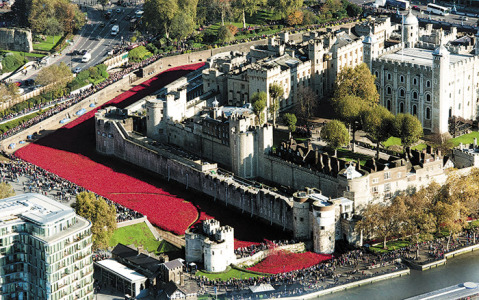
An aerial view shows visitors looking at the Tower of London’s poppy installation in London Nov. 4. The ceramic poppies symbolize the end of World War I and Remembrance Day, Nov. 11. (CNS photo/Hannah McKay, EPA)
In Natchez on the Feast of All Souls, parishioners processed to Catholic Hill in the city cemetery and prayed around the graves of their ancestors in the faith. This year they honored Msgr. Daniel O’Beirne, who served in Natchez, Vicksburg and as Chancellor of the diocese. He was a great assistant to Bishop Richard Gerow in developing the vast archives for the diocese.
Other parishes and schools throughout the diocese marked All Saints Day with festive costumes for children mimicking favorite saints – it seems as always the Blessed Mother, St. Joseph and St. Francis were the most popular.
In November we also remember our veterans on the11th, this past Tuesday. Veterans Day honors all those who have served in the military and recognizes those still serving who will one day become veterans – please God.
This year marks the 100th anniversary of the beginning of World War I, the Great War and supposedly the war to end all wars. Unfortunately, it did not.
There was a news story on the other night which featured the red poppies immortalized in Canadian doctor, soldier and poet John McCrae’s poem written during WWI in 1915 – “In Flanders Fields.”
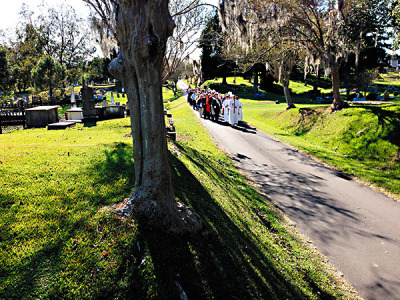
Natchez St. Mary Basilica parishioners process to Catholic Hill in the City Cemetery on Sunday, Nov. 2, the Feast of All Souls to pray and remember their Catholic ancestors. November is the month in which we honor the dead.(Photo by Patricia Murphy)
Poppies were the first signs of vegetation to grow again after the horrors of battles and death. Often “popping” up between graves on newly buried soldiers. The first stanza of the short poem sings:
In Flanders Fields the poppies blow
Between the crosses row on row,
That mark our place; and in the sky
The larks, still bravely singing, fly
Scarce heard amid the guns below.
Varied stories are told about the writing of the poem and its publication, but in England this year to honor the 888,246 fallen soldiers from that country and its colonies in WWI, artists made 888,246 ceramic red poppies and placed them around the dry moat of the Tower of London with the help of countless volunteers in a process that took months. The moat was filled with a sea of red which could be seen from thousands of feet in the sky. It appears as a river of blood flowing around and out of the fortress.
No one knows exactly how many died in combat and from disease in the war to end all wars. Estimates go from six million to upwards of 15 million – this total includes Colonel John McCrae who after many years of treating the wounded himself died of pneumonia in 1918 in a military hospital.
Europe lost almost an entire generation of young men, who never came home to marry and start families. The Great War marked the end to horseback sword wielding battle charges and opened the door to weapons of mass destruction.
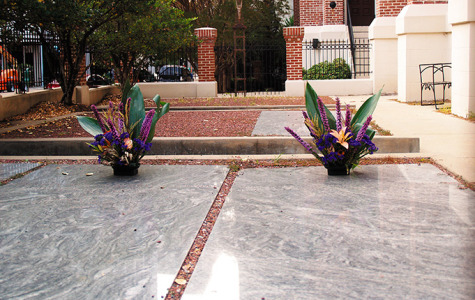
Flowers mark the graves of Bishops Richard Gerow and Joseph Brunini in the Bishops’ Cemetery outside St. Peter Cathedral in Jackson. (Photo by Mary Woodward)
And in that moat 888,246 lives are remembered – lives lost to a brutal war that left families and futures destroyed and landscapes scarred with trenches, barbed-wire and flowing blood. And in the cycle of nature, the poppies continue to grow and blow amidst this tragic human endeavor.
This November, I remember in a special way both my grandfathers one of whom spent 22 months as an artillery man in France during WWI and the other who wanted desperately to fight in this war but was caught in the worldwide flu epidemic of 1917 and never made it to foreign shores. I often wonder would I be here if he had made it to fight. So during this month honoring the dead take some time to remember all those among family and friends who have gone on before us and also offer up some prayers for those who have no one to remember them.
Eternal rest grant unto them, O Lord, and let perpetual light shine upon them. Requiescant in pace.
Embrace light, purpose of Advent
By Elsa Baughman
I remember reading years ago in a religious column that the only place where Advent has not disappeared is in the church. It usually begins at the end of November or early December, when people are thinking more about Christmas presents, parties and activities than preparing themselves spiritually for the coming of Christ. This liturgical season of anticipation can be very noisy, surrounded by secular music, lights, and television, newspaper and radio ads urging us to buy gifts for this or that special person.
When we go to church on the four Sundays of Advent we are reminded of the true meaning of this season by the Scripture readings which reflect on the coming of our savior.

COVINGTON – On October 25, 2014 Father Brian Kaskie, pastor of McComb St. Alphonsus, led a group of about 30 members from his parish to St. Joseph Abbey. The group attended Mass, ate lunch and had a tour of the Abbey, which has undergone recent renovations to mark its 125th anniversary this year. Diocesan seminarians attend the college there. (Photo submitted by Ruth E. Phillips)
Here in the Diocese of Jackson parishes and missions observe Advent with a variety of activities. Some schedule time for silent prayers and reflection, others hold retreats, candlelight vigils or celebrate daily Mass, and the majority offer penance services.
Just as last year, Pearl St. Jude Young Apostles will pray an illuminated Advent rosary in their rosary garden. In Corinth St. James Parish children brought ornaments (symbols of a Bible story or figure) to place on a “Jesse Tree” while hearing a short story about each character from the ancestry of Jesus during Advent last year.
New Albany St. Francis of Assisi Parish has spiritual reflections on Wednesdays. Every year, Madison St. Francis of Assisi Parish holds an Advent Fair where children make Advent wreaths for their homes.
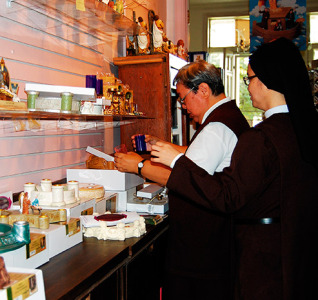
Carmelite Sisters L. J. Therese Lazard (left) and Mary Jane Agonoy arrange the display of the Advent wreaths at the Carmelite Gift Shop. The store carries a wide selection of wreaths, candles and pamphlets for the Advent season. The open house weekends and bake sales run from Nov. 15-Dec. 21. (Photos by Elsa Baughman)
The church does its best to encourage all of us during these four weeks to center our lives, minds and hearts on the coming of Christ. It’s up to us to hear the message and anticipate his coming, not with fanfare but with a quiet, humble heart, a burning heart.
For me, this year is special. I wanted to do something different to really immerse myself in the “coming” of our King. I bought an Advent wreath! I have been wanting to participate in this tradition for years, but always put it off for one reason or another.
The wreath is an old tradition meant to remind us of the coming of the light of the world. It has three purple candles, symbolizing penitence and preparation, and one pink candle, used on Gaudete Sunday, to symbolize hope. As the days of winter get darker and shorter, we light another candle each week until we welcome Christ, the real light of the world, at Christmas. There are many prayer books and online resources with prayers you can use with your Advent wreath.
As I light each candle on my Advent wreath, I am preparing my heart to receive Christ with a new purpose in life.
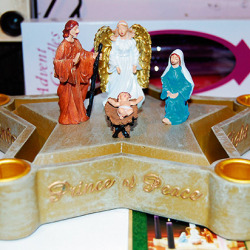
This Advent wreath is on sale at the Carmelite Gift Shop. The wreath is an old tradition meant to remind us of the coming of the light of the world.
I might also try to do something similar to what my sister does during Advent. She makes a list of simple things to do each day during the season – just one per day. For instance, one day she would pray for the intentions of the pope; another day she buys a small toy for a needy child, or calls a friend who is sick or going through a hard time in life. They are all very small sacrifices but with a kind, loving purpose.
During this Advent season, let us prepare our hearts to hear the message of our savior and receive him in all his glory.
(Editor’s note: see page 2 for Advent services and programs in parishes.)
Foster mother treated to service project
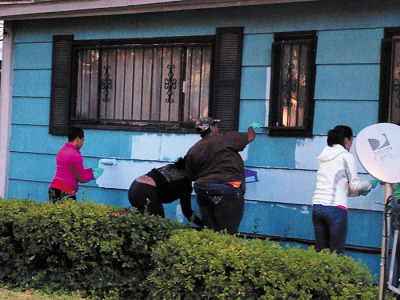
JACKSON – Volunteers from Mississippi Home Corporation repainted the home of Rosie Williams as part of a “Make a Difference” project, Thursday, Oct. 23. Williams has been a foster parent for Catholic Charities’ Therapeutic Foster Care program for more than 20 years. The Home Corporation provided the
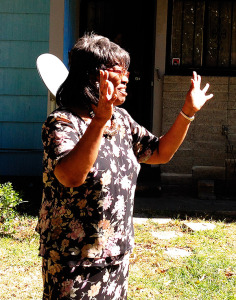
manpower, paint and materials for the project. This is the second time Catholic Charities has benefited from the organization’s generosity. Two years ago they painted rooms in the Domestic Violence shelter. (Photos by Kim Thomason)
Local Knights win national recognition
JACKSON – Knights of Columbus Council #15131 of St. Richard Parish has earned the distinction of Triple Star Council, for the 2013-2014 fraternal year. The award recognizes overall excellence in the areas of membership recruitment and retention, promotion of the fraternal insurance program and sponsorship of service-oriented activities. State Deputy Jim McCraw presented the award to members of the council at a special ceremony held on Wednesday, October 15.
The triple star refers to the fact that the council reached 300 percent of its quota.
“Please accept my sincere congratulations upon attaining this prestigious award. Your dedication to the Order is seen in the high standard of excellence you have achieved,” said Carl A. Anderson, chief executive officer of the national organization. “At the same time, I encourage you to carry forward this enthusiasm to meet the challenges that will face the Knights of Columbus in the years ahead. May this award be a reminder and an inspiration to the members of your council to continue to promote the ideals of Columbianism for the good of the church, your community and the order,” he added.
“Receiving the Triple Star Council Award is quite an honor for us. We’re extremely proud of the accomplishment,” proclaimed David Fisher, head of the local council.
The Knights of Columbus is the world’s largest Catholic lay organization. It provides members and their families with volunteer opportunities in service to the church, their communities, families and young people. With more than 1.8 million members in more than 15,000 councils around the world, the Knights of Columbus annually donates more than $10 million and 70 million hours of service to charitable causes.
Bishop Joseph Kopacz celebrates inaugural Red Mass for legal professionals
Biloxi’s retired bishop has been eyewitness to racial division, healing
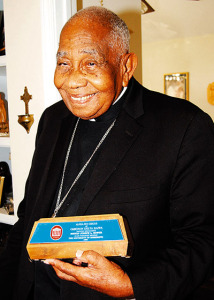
BILOXI – Bishop Howze lays hands on incoming Bishop Thomas Rodi during the latter’s July 2001 ordination Mass. (Gulf Pine Catholic file photo by Shirley Henderson)
By Terry Dickson
BILOXI (CNS) — The harsh realities of racial segregation were spelled out for Bishop Joseph Lawson Howze at an early age.
Bishop Howze, 91, a native of Daphne, Ala., was appointed the first bishop of Biloxi in 1977. He was the first black Catholic bishop in the 20th century to head a diocese, and at the time of his retirement in 2001, he was the top-ranking active black Catholic bishop in the U.S.
The bishop recently shared some recollections of growing up in the segregated South and how racial healing was gradually brought about through the 1964 Civil Rights Act.
“I think I was about nine years old when the Depression came on,” he said. “I remember that there was very strong segregation in Alabama, especially in Baldwin County. We went to public schools and the schools for the black kids were closed in March so they could work in the potato fields. The other schools were not closed. So that shows you the difference between the races during that particular time. Segregation was pronounced.”
However, Bishop Howze said his family was fortunate in that they were never the targets of serious racial backlash.
“My grandfather was a mulatto. He was half white. When the census was taken in 1930, my brother and I were listed as mulatto kids,” said Bishop Howze. “I didn’t realize it as a kid growing up, but I’m quite sure he got some privileges because of that. He was also a very strong man. He was a deacon in the Baptist church and I’m sure that, sometimes, he got a lot of things because of who he was.”
Nevertheless, Bishop Howze said that, as a young boy, he wondered about different aspects of racial segregation.
“I wondered why, when we got on a public bus, we had to sit in the back with a curtain drawn in front of us and things like that,” he told the Gulf Pine Catholic, newspaper of the Diocese of Biloxi. “But there was no racial violence directed toward me and my family when I was growing up.”
A cradle Baptist, Bishop Howze attended Most Pure Heart of Mary School in Mobile, Alabama, as a child, and became a Catholic at age 25 under the instruction of Josephite Father Benjamin Horton.
He met the priest through the family of a student who was in his homeroom. Bishop Howze taught high school chemistry and biology in Mobile’s public schools and also was assigned a homeroom.
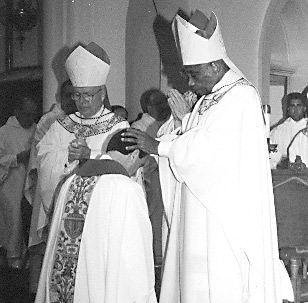
Retired Bishop Joseph Howze, 91, a native of Daphne, Ala., and the first bishop of Biloxi, Miss., proudly displays a plaque recognizing his induction into the University of Mississippi’s Alpha Phi Circle of Omicron Delta Kappa as an honorary member in 1988. In an interview Bishop Howze recalls his life and ministry when the South was segregated and describes the racial division and healing he has witnessed over the years. (CNS photo/Juliana Skelton, Gulf Pine Catholic)
The student, Marion Louis Carroll, was a Catholic. The youth’s parents invited him to dinner one evening and he met Father Horton.
Bishop Howze was baptized at Most Pure Heart of Mary Church in Mobile Dec. 4, 1948, and made his first Communion the next day at Our Mother of Mercy Mission Church.
Father Horton soon transferred and was replaced by Josephite Father Vincent Warren, who was “a very missionary-minded priest,” said Bishop Howze. “After my baptism, I used to travel with him to his mission churches. At the time, I was playing the organ and piano a little bit and would do the music for him. It was he who really inspired me to become a priest.”
While waiting to be accepted by a diocese as a seminarian, Bishop Howze spent a year teaching at St. Monica Catholic School in Tulsa, Oklahoma.
Bishop Vincent S. Waters of Raleigh, North Carolina, “adopted” him, he said, sent him to the diocesan preparatory seminary in Buffalo, New York.
After graduation, Bishop Howze was admitted to Christ the King Seminary at St. Bonaventure in New York, where he was the lone black seminarian but experienced no racial prejudice. He received his doctor of divinity degree in 1959 and was ordained for the Diocese of Raleigh that same year.
Bishop Howze served in several black parishes throughout North Carolina before being appointed pastor of the Basilica of St. Lawrence, a predominantly white parish in Asheville, in 1968.
“There was a period of adjustment,” he recalled, “but I got to know everybody and was loved by the people.”
However, he wasn’t immune to the indignity of racial segregation.
He described a meeting the Raleigh bishop had with priests at a Holiday Inn and the management of the hotel “made it known that they weren’t going to serve me at the dinner. So, the bishop and the entire group of priests left. It was terrible.”
In 1972, he was appointed auxiliary bishop of Natchez-Jackson, Mississippi. “I was scared to come here and wondered why I was being sent to this place where there was all this terrible racial segregation,” he said.
“But my bishop, Bishop Michael Begley, told me, ‘Almighty God is appointing you to go and serve the church in Mississippi and you do that. You’ll be OK.’ So I did and I was ordained a bishop 44 years ago.”
At the same time as Bishop Howze’s episcopal ordination at the Jackson Civic Center, a kneel-in supporting church desegregation was taking place down the street at the predominantly white First Baptist Church.
Bishop Howze’s first assignment in Mississippi sent him to Philadelphia where three civil rights workers — James Chaney, Andrew Goodman, and Michael Schwerner — were murdered in 1964.
“Could you imagine I went up there by myself? I didn’t have a driver. Cardinal Bernard Law was still in the diocese then as a young priest, but he didn’t go with me,” he said. “The Missionary Servants (of the Most Holy Trinity) were in charge of the parish in Philadelphia at the time. I was a little concerned about it, but everything went well. The confirmation class had black kids, white kids and Indian kids. I had no problems. It was an historic day.”
Bishop Howze’s appointment was a watershed moment for African-American Catholics. Then-Bishop Joseph Brunini of Natchez-Jackson “was looking for a black bishop to come here,” he recalled. “That’s the reason why I was named here.
As far as the changes that came about as result of the implementation of the Civil Rights Act, Bishop Howze found them to be “drastically wonderful.”
“Right now, there are more black mayors in Mississippi than any other city in the country and, of course, last year a black guy ran for governor and did well,” said Bishop Howze.
“The change in Mississippi was really phenomenal, and I think the reason was because the direct relationship between whites and blacks in the South was good,” Bishop Howze said. “I lived in a community in Mobile growing up with both whites and blacks living in the community. But racial segregation was still there.
“After we played, we couldn’t go to school together and we couldn’t go to church together, but we were friends. So I think that, after integration, it was easier for those whites, it was easier for those whites who wanted to integrate.”
He added, “Now I’m not saying that integration was easy in Mississippi. It wasn’t because the white kids left and went to private schools. So the public schools became predominately black schools. Then, effective changes were made. And I will say this. I have seen dramatic changes in race relations in Mississippi.”
(Dickson is editor of the Gulf Pine Catholic, newspaper of the Diocese of Biloxi. This story was part of a Catholic News Service series on the 50th Anniversary of the Civil Rights Movement.)
Purple Dress racers gather to ‘run’ domestic violence out of city
JACKSON – Cindy Hyde-Smith, commissioner of the State of Mississippi Department of Agricultural and Commerce, welcomes a crowd of more than 400 people of all ages who attended this year’s Purple Dress Run on Thursday, Oct. 23. Proceeds from the event sponsored by Catholic Charities, benefit the battered women’s shelter. Purple-clad participants gathered before sundown at Jaco’s Tacos for the 5K run/walk through downtown Jackson in support of awareness for domestic violence issues. Sam Rhodes, 23, a visitor from Virginia who was invited by his family to enter the run, was the first to cross the finish line at 6:19 p.m. After the race the crowd gathered at Jaco’s Tacos to continue the celebration with food, music and drink.
Michael Thomas, development director for Catholic Charities, (contributer of photo), said this year’s race was the most successful so far raising $18,000. “People went all out to make this a festive, friendly event,” Thomas added.



